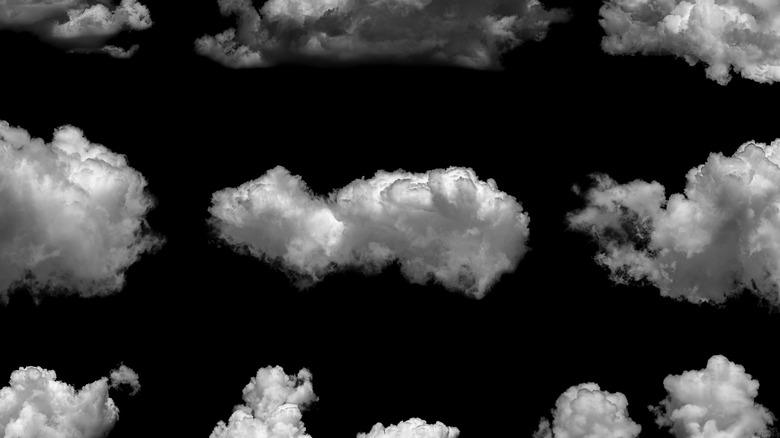The Scientific Reason Storm Clouds Look So Dark
For some, the sight of gathering storm clouds can invoke beauty and awe, a marvel to witness in the sky. For others, those same storm clouds may provoke feelings of fear and danger. One thing is clear though: storm clouds are an integral form of nature, and the water they produce with sound and fury gives us the calming flow of rain and rivers. The water cycle — the process in which water flows from the land to the sky continuously, from liquid, solid, and vapor — ultimately gives all organisms on our planet life, starting with the process of condensation (via National Weather Service).
Generally, most of us are aware that water is first warmed by sunlight; the ensuing interaction causes it to evaporate (i.e., transform from a liquid form into a vaporous one). This vapor then rises towards the sky where it cools, turning it into water droplets, which then condense into clouds, as the U.S. Geological Survey explains on their website. However, the process of condensation is only the first step. After that, these water droplets will soon become rain, or precipitation, turning into grey rain clouds. But why are rain clouds dark to begin with? For that, one will have to know a bit about how light and color work first.
Clouds get their color from sunlight
As many a sky-gazer might be aware, clouds come in all shapes, sizes, and colors. In total, there are about ten different types of clouds: among them cumulus clouds, altostratus clouds, and cirrus clouds (via National Weather Service). For the most part, all clouds, no matter what their type, get their coloring the same way: through sunlight. In order to understand this, one must first know how wavelengths and light work to create color.
According to the BBC's Science Focus site, light on earth comes directly from our sun, which means that color also comes from the sun. Sunlight contains every color evenly, which means that humans are able to perceive many different types of colors. Similar to how starlight may fill the skies at night, the sun gives the planet its warmth and illumination.
As summarized in a write-up published by The Eagle, this principle applies to clouds as well — though with a few added steps. Clouds get their color from sunlight, but clouds also scatter light, as they are made up of water droplets. This scattering gives clouds their signature white color. (The same phenomenon makes clouds red or pink sometimes as the sun sets, per New York Times).
Storm clouds are dark and thick due to water retention
So, how are gray and dark clouds made then? Using the same scientific principles, rain clouds also scatter light, just as white clouds do, but how much light they scatter is entirely dependent on their thickness. Per Live Science, clouds can actually vary in both thickness and height, and what determines this is how many water droplets or ice crystals a cloud may contain at any given time. As explained above, the water cycle means that clouds will eventually precipitate (i.e., release the water they hold), starting the cycle over again.
According to National Geographic, clouds that hold more water reflect less light, which gives them a darker coloring. This means that thick clouds also scatter more light, giving them their darker hues and tones. In rain clouds, there are large, vacuous spaces in between each drop of water they hold. Conversely, thin clouds carry less water, which allows light to penetrate through them more easily. One can think of this as a metaphor for a wall, in that thinner, porous walls allow for things to penetrate them more easily, while thicker, less porous walls are more likely to deflect and scatter things, rather than allow them to penetrate (via Scientific American). Suffice it to say, clouds are some of the Earth's most fascinating and beautiful things to look at, whether it be looking up from the ground or below from a plane — and knowing how they work may further our appreciation of them.


